The Emotion Wheel: What It Is and How to Use It [+PDF]
 Can you guess how many emotions a human can experience?
Can you guess how many emotions a human can experience?
A study by The Greater Good Science Center suggests there are 27 distinct emotions – at least (Cowen & Keltner, 2017). And that does not even include combinations of emotions.
With so many emotions, how can one navigate the turbulent waters of feelings, without getting lost?
The answer: with an emotion wheel.
Through years of studying emotions, American psychologist Dr. Robert Plutchik proposed that there are eight primary emotions that serve as the foundation for all others: joy, sadness, acceptance, disgust, fear, anger, surprise, and anticipation. (Pollack, 2016)
So while it’s hard to understand all 34,000 distinct emotions, we can learn how to identify the primary emotions and act accordingly. It’s especially useful for moments of intense feeling and when the mind cannot remain objective as it operates from an impulsive “fight or flight” response. (Watkins, 2014)
Before you read on, we thought you might like to download our three Emotional Intelligence Exercises for free. These science-based exercises will not only enhance your ability to understand and work with your emotions but will also give you the tools to foster the emotional intelligence of your clients, students or employees.
This Article Contains:
- What is Plutchik’s Wheel of Emotions?
- How to Use Plutchik’s Wheel of Emotions
- 2 Emotion Wheel Worksheets
- What is the Difference Between Plutchik’s Wheel of Emotions and the Geneva Emotion Wheel?
- How to Use an Emotion Wheel in Counseling with Quenza
- Controlling Emotions Through Vertical Development
- A Fun Test Using Plutchik’s Wheel of Emotions: Who Are You Really According to the Emotion Wheel?
- A Take-Home Message
- References
What is Plutchik’s Wheel of Emotions?
Let’s take a look at each of these emotions. But first, how about a clear idea of what we mean when we use the term “emotion.”
In previous studies, researchers of emotions saw them as episodes influenced by stimuli. More specifically,
“emotion is defined as an episode of interrelated, synchronized changes in the state of all or most of the five organismic subsystems in response to the evaluation of an external or internal stimulus event as relevant to major concerns of the organism” (Emotion Researcher, 2015).
Below is a table from the International Handbook of Emotions in Education. It shows the relationship between these various factors and sub-systems, as well as their presumed functions (Pekrun & Linnenbrink-Garica, 2014). There are also plenty of books on emotional intelligence.
| Component | Primary Function | Examples |
|---|---|---|
| Subjective feeling | Monitoring | Sadness, happiness, gratitude, anger, feeling good |
| Action tendency | Motivation | Urge to weep, to jump up and down, to approach |
| Appraisal | Meaning making | I just lost something; I just received a gift; I passed a difficult test, something good happened to me |
| Motor activity | Communication | Crying, smiling, raising one’s chin, making oneself small, moving one’s arms up and down quickly |
| Physiological | Support | Changes in pulse, blood flow, brain activity |
Emotions influence our actions in five main ways.
1. Emotion Component
This is where an individual simply experiences the feelings. It’s about monitoring the internal universe and recognizing what is being experienced at that time.
2. Action Tendency Component
Once the emotion is identified, the body moves into action. Emotions bestow certain actions instead of others, which means that while some are beyond our control (and thankfully so), like pulling your hand away from a hot iron, others are within our control, facing the fear to continue with a speech or a presentation.
3. Appraisal Component
By cognitively analyzing the emotion, the individual is able to pick up on the situations, actions, environments, or individuals that are causing the emotion. This aids the individual in tracking how these stimuli impact their wellbeing. It’s also invaluable for helping communicate the state of our internal world with others.
4. Motor Component
This is the communicative function of how we express what we are experiencing (facial expressions, hand gestures, body movements, etc.). So it is extremely important on the inter-individual level, as well as that of the individual.
5. Physiological Component
This component supports all others and is the chemical reaction that our body experiences. For instance, the rush of blood flow to the hands occurs when one experiences the emotion of anger.
While the components of the emotions we feel are present in all individuals, the intensity and expression of these emotions differ from one person to another. There are also social factors like gender, culture, and race, that influence why people may feel emotions differently despite similar situations.
For example, hearing words like: “I am afraid,” “I feel jittery,” “I don’t want to be here,” or “I just don’t have enough time to prepare for the final,” are all part of the different components of an emotion.
“The first expression (I am afraid) describes a subjective feeling of fear. The second example (I feel jittery) refers to the physiological component of an emotion. The third example (I don’t want to be here) indicates an avoidance action tendency, which may or may not be carried out. The fourth example describes several appraisals of the situation, including goal frustration (I am not prepared) and lack of power (I do not have enough time). Observable motor activities are also associated with emotions. For example, facial expression, such as smiling or frowning, body postures, such as opening the arms or raising the fists, and changes in the voice, such as raised pitch, can be observed in emotional situations.”
(Pekrun & Linnenbrink-Garica, 2014)
The Wheel of Emotions
Now that the complex system of emotions, and all its components, is a bit more clear, we can dive into the work of Plutchik and his wheel. (Pico, 2016)
The eight primary emotions that he identified, which are the basis for all others, are grouped into polar opposites:
- joy and sadness
- acceptance and disgust
- fear and anger
- surprise and anticipation
The foundation of his emotions theory stems from the following ten postulates:
(Changing Minds, 2016)
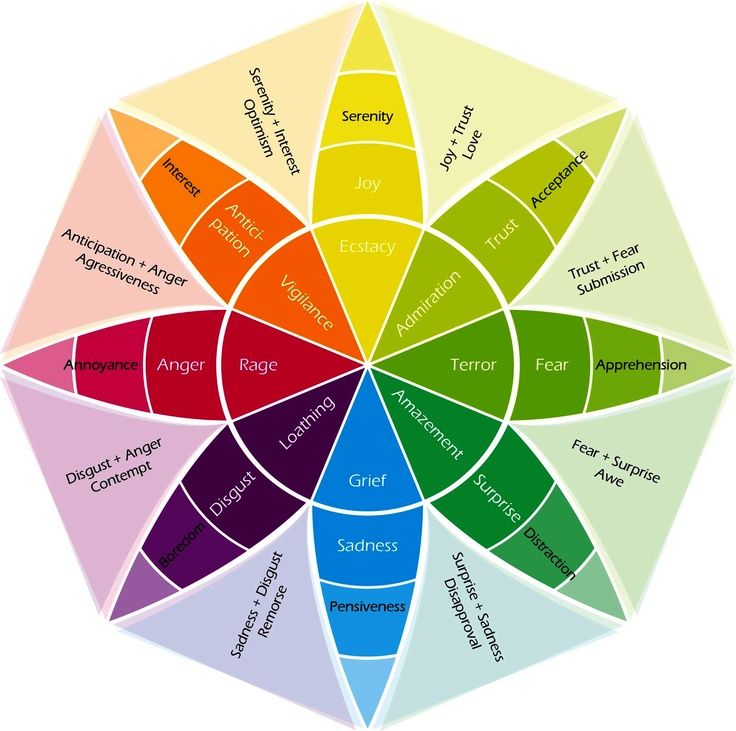
- Animals and Humans
The midbrain (or the limbic system) of a human is similar to that of other mammals. Animals and humans experience the same basic emotions. - Evolutionary History
Emotions came into being as part of the evolutionary process, long before there were apes or humans. - Survival Issues
The most influential role of emotions is to help us survive. - Prototype Patterns
These are the common identifiable patterns and elements that make up each emotion. - Basic Emotions
The most basic emotions are the primary ones: trust, fear, surprise, sadness, disgust, anger, anticipation and joy. - Combinations
The adding up of these various primary emotions will produce new ones such as: love = (joy+ trust), guilt = (joy + fear), and delight = (joy + surprise). - Hypothetical Constructs
Emotions are constructs, or ideas, that help describe a certain experience. - Opposites
Like many things in nature, there is a duality with emotions, hence each one has its polar opposite:
– saddens is the opposite of joy
– trust is the opposite of disgust
– fear is the opposite of anger
– surprise is the opposite of anticipation - Similarity
The degree of similarity determines which emotions are more related, and which ones are the complete opposite. - Intensity
This degree of change in intensity, from very strong to not so much, produces the diverse amount of emotions we can feel. Such as:
– trust goes from acceptance to admiration
– fear goes from timidity to terror
– surprise goes from uncertainty to amazement
– sadness goes from gloominess to grief
– disgust goes from dislike to loathing
– anger goes from annoyance to fury
– anticipation goes from interest to vigilance
– joy goes from serenity to ecstasy
Elements of the Wheel
Looking at the wheel we can notice three main characteristics:
Colors
The eight emotions are arranged by colors that establish a set of similar emotions. Primary emotions are located in the second circle. Emotions with softer colors are a mix of the two primary emotions.
Layers
Moving to the center of the circle intensifies the emotion, so the colors intensify as well. For instance, at the center of the wheel, the primary emotions change from: anger to rage; anticipation to vigilance; joy to ecstasy; trust to admiration; fear to terror; surprise to amazement; sadness to grief; disgust to loathing. Moving to the outer layers, the colors become less saturated, and the intensity of the emotions lowers.
Relations
The polar opposite emotions are across from each other. The spaces between the emotions demonstrate combinations when primary emotions mix. So we see the emergence of emotions like love, submission, optimism, aggressiveness, contempt, remorse, disapproval, awe, and submission.
The ability to identify one’s emotions is a skill related to emotional intelligence (Salovey & Mayer, 1990).
Those high in this skill can communicate more detailed emotional experiences and use a greater emotional vocabulary. Research has found that helping individuals expand their emotional vocabulary can help them regulate their emotions more effectively (Kircanski et al., 2012).
The Feeling Wheel was designed by Gloria Willcox (1982) and is a great starting point for those who find it challenging to identify their emotions.
You can use the wheel for:
- Exploring the emotions you are feeling at any given moment of the day.
- Daily self-reflection where you identify the emotions you experienced throughout the day.
- Exploring deeper and longer-term emotions that may be affecting you.
- Helping your therapy or coaching clients describe their experiences in greater detail.
It must be noted that you can experience a diverse number of emotions simultaneously, and that the wheel should not be used for avoiding emotions or replacing ‘negative’ emotions with ‘positive’ ones. Instead, the goal is to identify your emotional experience, accept it as it is, and communicate it if you wish.
How to Use Plutchik’s Wheel of Emotions
The beauty of this tool is in its ability to simplify complex concepts. Understanding is a crucial step to solving any dilemma. When the question concerns our emotions that we process on a subconscious level, it can be hard to first identify and verbalize our needs.
This is why the tool is so useful. It enables the user to visualize their emotions, and understand which combinations of emotions created this outcome.
Once we objectify and understand the emotions, we can empathesize with ourselves, and channel our focus in the direction of emotions we actually want to feel.
There are two ways to use the wheel, either as a two-dimensional circle or a three-dimensional ellipse. Utilizing it as a two-dimensional circle lets the individual dive into the emotion wheel. This then helps them discover what primary emotions they are feeling, as well as how emotions combine to create secondary emotions like awe, remorse, aggression, optimism, etc.).
When utilizing it as a three-dimensional form, the individual can view the emotional intensity of the primary and secondary emotions. (Roeckelein, 2006)
According to Plutchik’s Sequential Model, emotions are activated due to specific stimuli, which set off certain behavioral patterns. (Krohn, 2007)
He identified the following survival behaviors that drive our actions:
Protection: Withdrawal, retreat
(activated by fear and terror)
Destruction: Elimination of barrier to the satisfaction of needs
(activated by anger and rage)
Incorporation: Ingesting nourishment
(activated by acceptance)
Rejection: Riddance response to harmful material
(activated by disgust)
Reproduction: Approach, contract, genetic exchanges
(activated by joy and pleasure)
Reintegration: Reaction to loss of nutrient product
(activated by sadness and grief)
Exploration: Investigating an environment
(activated by curiosity and play)
Orientation: Reaction to contact with an unfamiliar object
(activated by surprise)
(Screenr, 2017)
This means that when our emotions are activated, they are done so to elicit one of the survival behaviors. Of course, all of this happens on a subconscious level.
2 Emotion Wheel Worksheets
To tap deeper into the mind and get to the root cause of these internal emotions, here are several worksheets to assist through the process:
- Clear and brief: emotions
Provides a snapshot view of emotions, and the way they are trigged in the mind. Outlines the developmental levels our emotions grow through. And what it means to be emotionally intelligent. - Seeing Emotions
Sometimes it helps to see a visual explanation of a word or concept. If you would benefit from common facial expressions associated with each emotion, then this worksheet is for you. Browse and identify feelings by matching their expressions. - Extra: How to Improve Emotional Intelligence in the Workplace.
What is the Difference Between Plutchik’s Wheel of Emotions and the Geneva Emotion Wheel?
Plutchik’s wheel is not the only tool available for understanding and interacting without emotions. There are other emotion wheels that help us understand and detect our emotions, such as the Geneva Emotion Wheel (GEW). (Affective Sciences, 2017)
While both wheels focus on emotions and their intensities, the GEW uses a different approach. To start with, there are no primary emotions, rather a set of 20 emotions that are evaluated by two sets of polar parameters (version 2.0 has 20 emotions, while the first model listed 16).
The two parameters are valence (describing a situation as unpleasant or enjoyable), and control/power (looking at whether or not the individual has high or low control over the situation, and it’s outcomes).
Another big difference between the two is the intensity of the emotions. The GEW has reversed its intensity, with the strongest emotions represented by larger circles on the outer layers; these decrease in size as they approach the center.
One of the biggest differences between these emotional intelligence tools is that the Geneva Emotion Wheel also gives individuals an ability to select options for ‘no emotions’ or ‘other emotions.’
That’s because it “gives respondents much freedom to express themselves. [It’s important to] note that a pure free response format can be disadvantageous because there may be a huge variation in how and how well respondents express themselves in their own words (e.g., Gohm & Clore, 2000), and the resulting variability in measurements across individuals and situations may reduce measurement reliability.” (Sacharin, Schlegel, & Scherer, 2012)
Another big difference is that Plutchik’s wheel does not express emotions such as pride and shame, which the GEW does. Aside from that, both tools provide a great starting point for detecting one’s emotions.
How to Use an Emotion Wheel in Counseling with Quenza
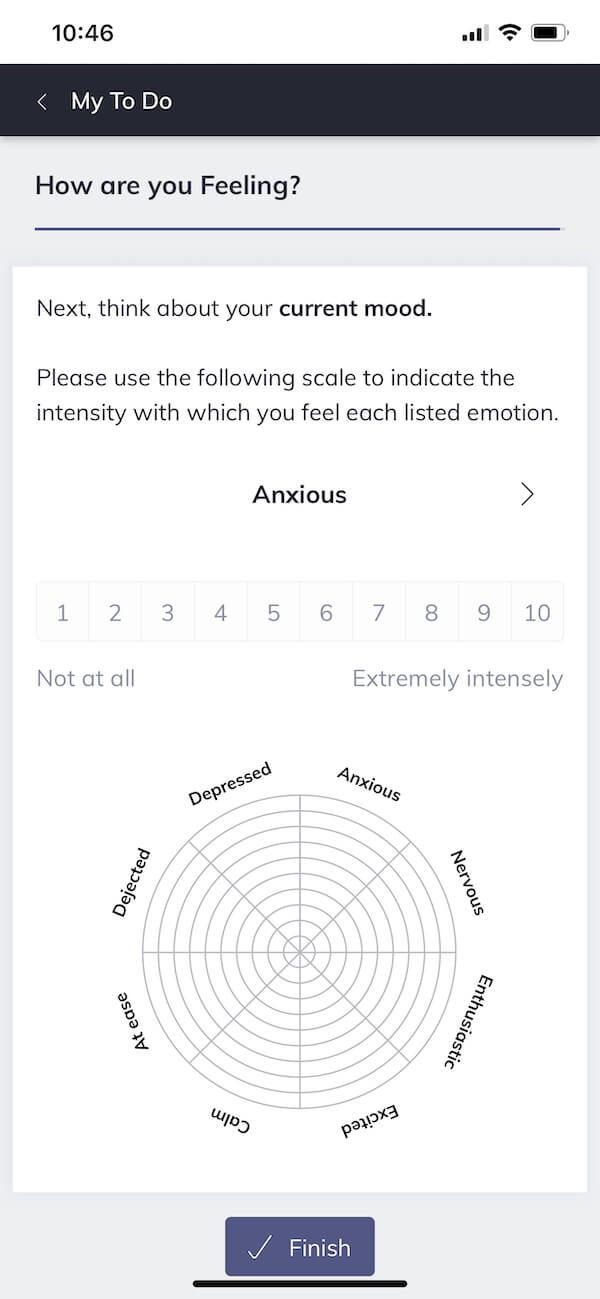
For example, suppose you’d like to better understand your client’s baseline emotional state on an average day. In that case, you could ask them to complete an emotion wheel as part of a standardized set of intake materials.
Alternatively, perhaps if your client has a mood disorder or experiences rapid fluctuations in emotions, you can invite them to complete emotion wheels as a form of reflection following emotionally heightened events throughout their day.
For a useful tool to facilitate either approach, check out the digital e-therapy app Quenza. The platform provides a simple way for helping professionals design and share reflection activities, questionnaires, and more, all using a simple drag-and-drop builder.
Among the various items you can include in your activities is a ‘wheel,’ which can be labeled with emotions according to one of the frameworks we have explored.
When completing your wheel activity, clients can provide ratings (e.g., regarding the intensity or frequency of that emotion) for each wedge of the wheel. Counselors can then use the final result, which looks like a spider chart, to facilitate discussion and reflection.
This is just one of the useful tools in Quenza that can be customized to help your clients learn about their emotions. If you’d like to learn more about Quenza and its functions, check out this psychoeducation interventions case study article or consider taking advantage of the platform’s risk-free 30-day trial.
Controlling Emotions Through Vertical Development
Human development goes through phases of self-awareness. Here is a great video that explains in detail why understanding what we feel is so important.
As Dr. Watkins explained, most individuals stay stuck in the consciousness state of a nine-year-old, due to the set of rules that the educational system, the society, and the corporate world impose. How bizarre is that?
When a crisis enters our lives (or another intense event), we start asking more questions about the role we play in the world. We start paying attention to the emotions and the messages they send to themselves and others.
When people are ready to face their negative or positive emotions, the inability to verbalize makes this developmental process difficult. When in distress, utilizing these emotional tools helps us establish a plan of action.
As a first step, individuals can examine their emotions, understand what events and stimuli activate certain emotions for them, and the outcomes that tend to follow. For example, before a dinner party or similar social event, a human might feel “apprehensive” because they want to feel like they belong to a particular group. By understanding and labeling this emotion, the person might be less hard on themselves for feeling a bit nervous.
Emotions influence our health, performance, wellbeing, motivation, sense of fulfillment, and decision-making skills. It’s important to understand and manage them.
When people don’t understand their current emotion, they may panic as their internal locus of control leaves them in disillusionment. This is natural, hence the importance of recognizing our feelings. As a review, individuals with an internal locus of control believe that,
“events in one’s life, whether good or bad, are caused by controllable factors such as one’s attitude, preparation, and effort” (Grinnell, 2016).
Wheels in Counseling
These tools are valuable for individuals in counseling sessions as one way to pinpoint the exact emotion (from a list of many) and understand how the emotion was created. Such answers can provide clarity and guidance towards solutions, rather than a fixation on the problems that caused the dilemma or intense feelings.
Below is the chart of the combinations one can have when mixing the primary emotions (Anderson, 2017).
Once the individuals identify what they’re feeling and why they’re feeling it, counselors can dive into the subconscious and make sense of what is and isn’t working.
That’s where the tool comes in. It helps in the following four ways:
1. Simplifies emotions
Walking around with a mind full of confusion and uncertainty can make anyone feel sad or overwhelmed. This is especially true of clients and individuals who want to understand themselves or a stressful situation, but don’t know where to start. With a wheel of emotions, the client can browse the various emotions and pinpoint the specific ones they’re experiencing.
2. Outlines the personal sequential model
By examining the primary emotions, one can start to consider what sparks the stimuli, how the emotion is expressed (it’s physical and mental aspects), and the actions it propels one to take.
By drafting one’s own chart of stimuli events, cognitive appraisal, subjective reaction, behavioral reaction, and function, an individual can become more aware of their habits and behaviors.
Maintaining a journal of emotions, where one writes about what they felt throughout the day and what caused it, is a great way to incorporate reflection with this tool.
3. Provides an opportunity for sharing
When someone shares their emotions and deep internal feelings with another, it creates an environment of trust and openness.
By sharing, the client can open up and initiate propulsion for change and self-improvement. It also helps create a positive rapport between the client and counselor or therapist.
4. Empowers individuals
Being attuned with what one is feeling (and therefore doing) can be empowering. Instead of trying to suppress, reject, or ignore emotions, people learn how to express and share them in a constructive way, as well as analyze the role they play in one’s life.
Gaining awareness in this area can give clients a chance to align themselves with the things they want, the outcomes that interest them, and the emotional states that help them work towards their goals despite imminent challenges. (Minter, 2014)
A Fun Test Using Plutchik’s Wheel of Emotions: Who Are You Really According to the Emotion Wheel?
Those who are curious to see what their emotions reveal about them, and how it influences their personality can take any one of these emotional intelligence tests.
The knowledge one walks away with, about the self, gives clarity and understanding, which is essential for development and growth. It expands one’s cognition, which is crucial in our judgment, problem-solving, higher-level thinking, planning, imagination, perception, and more.
In fact,
“the main way in which cognitions and emotions are linked is through appraisals. When anything happens, we evaluate what it means for us, its significance to us – this is an emotional appraisal, or an appraisal that leads to an emotional reaction. These appraisals are believed to help us in making fine distinctions about our emotional experiences or in determining the extent or the intensity of the emotion.”
(Ogelk, 2017).
The next time one is experiencing certain emotions (which is an energy in motion), the individual has the ability to utilize all their gathered information, and self-knowledge, to find the path towards the outcomes they desire.
Those wishing to expand their knowledge of emotions can take a look at these further resources, including a video explaining why suppressing emotions is a bad idea.
Worksheets for Children
There are several tools that can help children understand their emotions. With the release of Pixar’s animated movie, Inside Out, which focuses on the emotions we feel within us, there are many materials available to start such conversations with younger kids.
These tools include worksheets like board games, a memory journal, and ideas for kids to draw and share their feelings with parents, teachers, and other caregivers (Mehlomakulu, 2015). You will find a wealth of these tools in our article Is Emotional Intelligence Relevant for Kids?
An Animated Video about Emotions
This video explains why trying to suppress or ignore emotions can lead to many more problems than solutions. While it’s true that there are more negative emotions (shame, fear, sadness, anger, disgust) than positive ones (happiness, surprise/interest), both are vital for our survival.
That’s because our real emotions help us get what we really want. And by listening to the emotions we’ve been carrying around, but have been ignoring, we can release the stagnant ones and make room for new ones.
A Take-Home Message
The main takeaways from the above video help summarize the usefulness and application of Plutchik’s Wheel of Emotions, as well as other similar tools.
These golden rules are:
- Learn to attend to your emotions
- Become curious and patient with your emotions
- Talk about them and show your real emotions to others
- Learn to accept having different emotions
- Change your emotions with other emotions
With the wheel of emotions and these golden rules in hand, life can become more manageable. Imagine a world where everyone had the language to pinpoint an emotion, and understand what they felt. It would help communication in every field.
Do you use the wheel of emotions in your practice or daily life? If so, we would love to hear from you in our comments section below.
For further reading, please see the following five articles on emotional intelligence:
- The Importance of Emotional Intelligence
- How To Improve Emotional Intelligence Through Training
- Emotional Intelligence and Leadership Effectiveness + 69 Exercises
- Teaching Emotional Intelligence to Teens and Students
- Emotional Intelligence Skills and How to Develop Them
If you’re looking to help your clients become more emotionally intelligent by sharing online exercises and tools with them, the new Quenza application will help you do exactly that.
We hope you enjoyed reading this article. Don’t forget to download our three Emotional Intelligence Exercises for free.
- Affective Sciences. (2017, September 27). The Geneva Emotion Wheel – CISA – UNIGE. Retrieved from http://www.affective-sciences.org/gew
- Anderson, J. (2017, March 26). Dyad & Compound Emotions. Retrieved from https://gatehealing.com/dyad-compound-emotions/
- Changing Minds. (2016). Plutchik’s Ten Postulates. Retrieved from http://changingminds.org/explanations/evolution/plutchnik_postulates.htm
- Complete Coherence. (2017). Universe of Emotions. Retrieved from http://www.complete-coherence.com/universeofemotions/
- Cowen, A. S., & Keltner, D. (2017). Self-report captures 27 distinct categories of emotion bridged by continuous gradients. Proceedings of the national academy of sciences, 114(38), E7900-E7909.
- Emotion Researcher. (2015, March). The Component Process Model of Emotion, and the Power of Coincidences | Emotion Researcher. Retrieved from http://emotionresearcher.com/the-component-process-model-of-emotion-and-the-power-of-coincidences/
- Grinnell, R. (2016, June 17). Internal Locus of Control. Retrieved from https://psychcentral.com/encyclopedia/internal-locus-of-control/’
- Kircanski, K., Lieberman, M. D., & Craske, M. G. (2012). Feelings into words: Contributions of language to exposure therapy. Psychological Science, 23(10), 1086-1091.
- Krohn, M. (2007). Robert Plutchik’s Psychoevolutionary Theory of Basic Emotions. Retrieved fromhttps://dragonscanbebeaten.files.wordpress.com/2010/06/robert-plutchiks-psychoevolutionary-theory-of-basic-emotions-poster.pdf
- Mehlomakulu, C. (2015, July 18). Using “Inside Out” to Explore Emotions. Retrieved from http://creativityintherapy.com/2015/07/using-inside-out-to-explore-emotions/
- Minter, A. (2014, February 26). What Is The Feeling Wheel? Retrieved from http://www.passionprovokers.com/blog/why-use-a-feeling-wheel
- Ogelk. (2017). Emotion Cognition Motivation. Retrieved from http://www.ogelk.net/dersnot/tip/Emotion_cognition_motivation.pdf
- Pekrun, R., & Linnenbrink-Garcia, L. (2014). International Handbook of Emotions in Education, Chapter 2: Concepts and Structures of Emotions.
- Pico, I. (2016, March 23). The Wheel of Emotions, by Robert Plutchik | PsicoPico. Retrieved from http://psicopico.com/en/la-rueda-las-emociones-robert-plutchik/
- Pollack, D. (2015, November 12). Plutchik’s Wheel of Emotions Cheat Sheet. Retrieved from https://www.cheatography.com/davidpol/cheat-sheets/plutchik-s-wheel-of-emotions/pdf/
- Roeckelein, J. (2006). Elsevier’s Dictionary of Psychological Theories.
- Sacharin, V., Schlegel, K., & Scherer, K. (2012, August 13). Geneva Emotion Wheel Rating Study. Retrieved from http://www.affective-sciences.org/files/4514/6720/4016/Geneva_Emotion_Wheel_Rating_Study_Report_2012_08_11_2.0.pdf
- Salovey, P., & Mayer, J. D. (1990). Emotional intelligence. Imagination, Cognition and Personality, 9(3), 185-211.
- Screenr. (2017). Plutchik’s Wheel of Emotions: How Does It Work, and How Can It Be Applied? – Book Chapter Overview. u3083644. Retrieved from https://www.screenr.com/ZVDN
- Watkins, A. (2014, October 29). How Controlling Your Emotional Responses Can Improve Your Performance at Work. Retrieved from https://trainingmag.com/how-controlling-your-emotional-responses-can-improve-your-performance-work
- Willcox, G. (1982). The feeling wheel: A tool for expanding awareness of emotions and increasing spontaneity and intimacy. Transactional Analysis Journal, 12(4), 274-276.
Let us know your thoughts
Read other articles by their category
- Body & Brain (49)
- Coaching & Application (57)
- Compassion (26)
- Counseling (51)
- Emotional Intelligence (24)
- Gratitude (18)
- Grief & Bereavement (21)
- Happiness & SWB (40)
- Meaning & Values (26)
- Meditation (20)
- Mindfulness (45)
- Motivation & Goals (45)
- Optimism & Mindset (34)
- Positive CBT (28)
- Positive Communication (20)
- Positive Education (47)
- Positive Emotions (32)
- Positive Leadership (18)
- Positive Parenting (4)
- Positive Psychology (33)
- Positive Workplace (37)
- Productivity (16)
- Relationships (46)
- Resilience & Coping (36)
- Self Awareness (21)
- Self Esteem (38)
- Strengths & Virtues (31)
- Stress & Burnout Prevention (34)
- Theory & Books (46)
- Therapy Exercises (37)
- Types of Therapy (64)

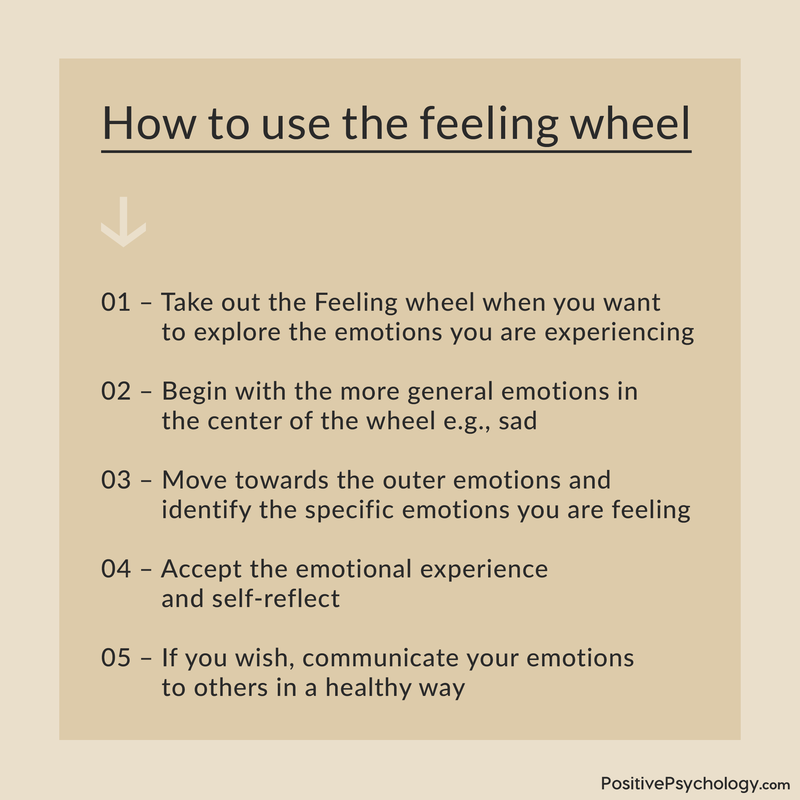
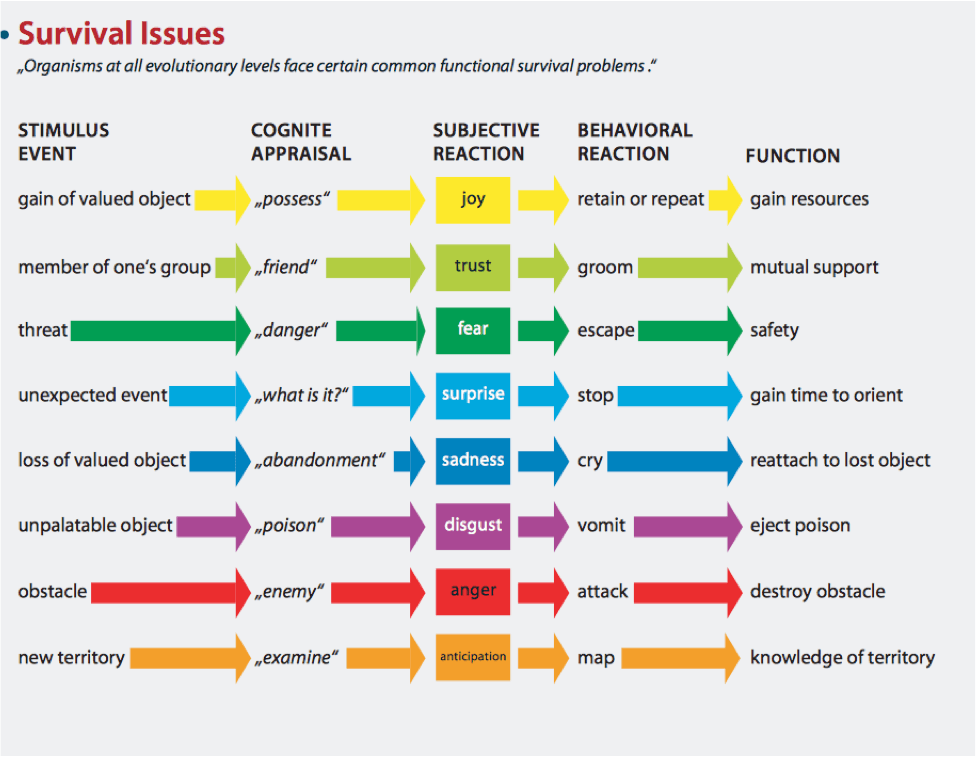

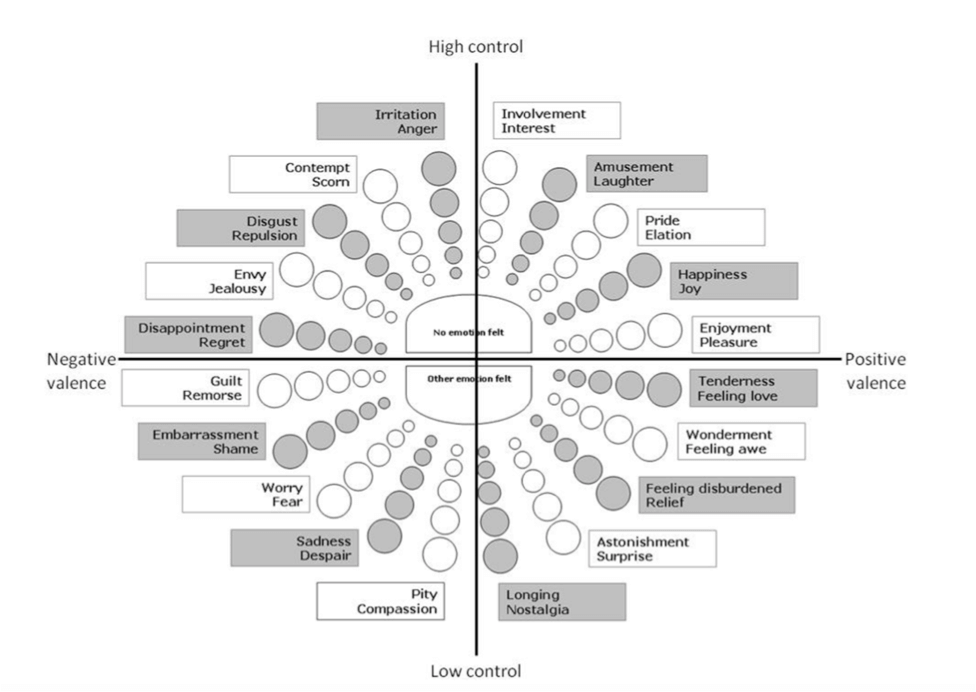
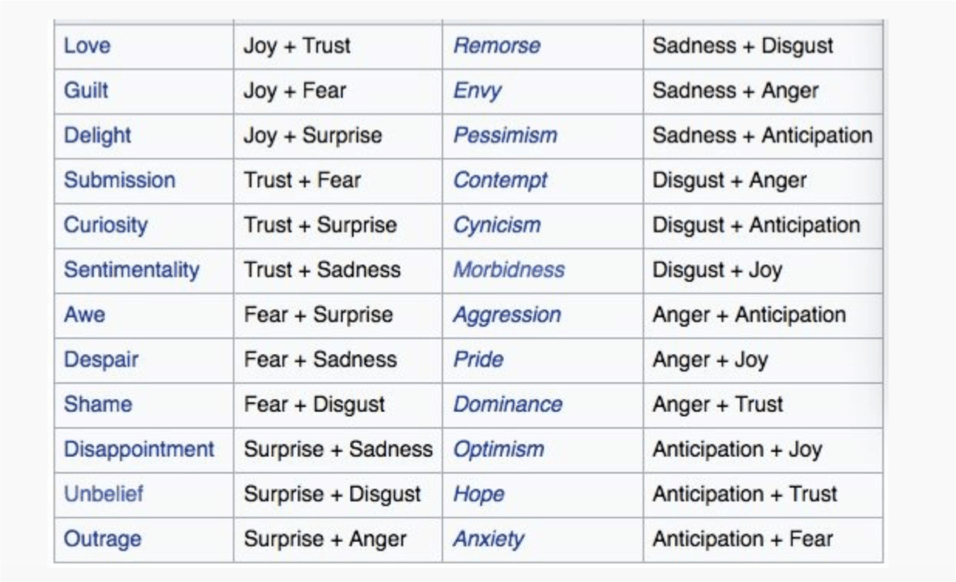
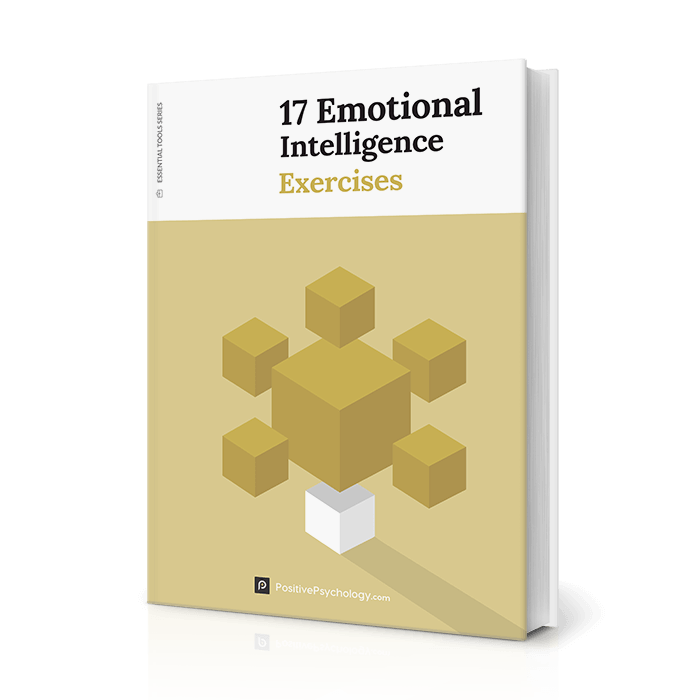
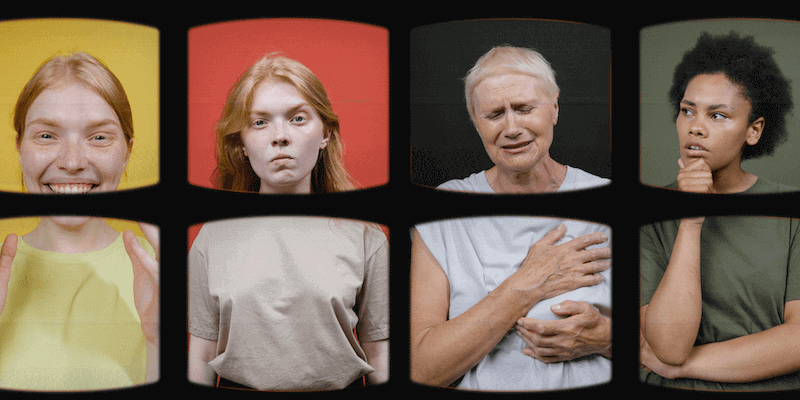


What our readers think
nice jobs thx
Great content. Weird that you do not mention Russell’s Circumplex model as the inspiration and basis of Plutchik’s emotion wheel?
I liked the links to academic papers, it approved me that this text is scientific, and at the same time showed me many connections to other concepts. However I would like to make more connections between Paul Aikman’s feelings wheel and MBTI. I wonder if there are any scientific papers showing a relation between “understanding the world”-“taking decisions” in MBTI and wheel of feelings.
Thank you very much. Calmed me down the moment I started to read this.
A key component seems to be the addition of high activation (characteristic of rage). This makes hatred different from loathing as you can loathe something without it being a physiologically activating experience.
We have a nine-year-old with big feelings, which has prompted us to explore how to navigate feelings more intentionally. We homeschool, and are using aspects of this article to help all three of our children in better understanding of themselves (and us parents as well). Making our own illustration of the chart for the wall! Thank you for sharing this life-changing stuff!
Just curious. What ever happened to HATRED? Hatred is a very angry emotional response towards certain people or ideas, usually related to disliking something. Hatred is often associated with intense feelings of anger, contempt, and disgust. Hatred is sometimes seen as the opposite of love. For such a commonly identified emotion, I do not see it in any of these charts.
Hi Dr. Cavanaugh,
That’s a great question! I’m not an emotions researcher, so I can’t give you a definitive answer. But my sense is that hatred lies somewhere between loathing and rage. A key component seems to be the addition of high activation (characteristic of rage). This makes hatred different from loathing as you can loathe something without it being a physiologically activating experience. Like I can loathe brussels sprouts without getting fired up at the thought of them.
This would be my best guess 🙂
– Nicole | Community Manager
Lovely read…helped me design a food menu
Hi there,
A client of mine is writing an article and found the image of the emotion wheel in this piece (https://positivepsychology.com/emotion-wheel/) very useful. I was wondering if we’d be able to use the image in our piece and credit this article? Also, are you the original creators of this image?
Thank you so much for your help and guidance!
Hi Madison,
Yes, we created this image based on Plutchik’s model. You’re welcome to use this image for research purposes provided you include a citation linking to this article. If you’d like to republish it for commercial purposes, please drop an email to info@positivepsychology.com letting us know a few details about your business and how you intend to use it. You can also find a version of this image free for public use in Wikimedia Commons.
Hope this helps!
– Nicole | Community Manager
Sounds great, thanks so much for your help!
I LOVE THIS WEBSITE, thanks for writters who contribute the knowledge, with more detail about it, thank you….